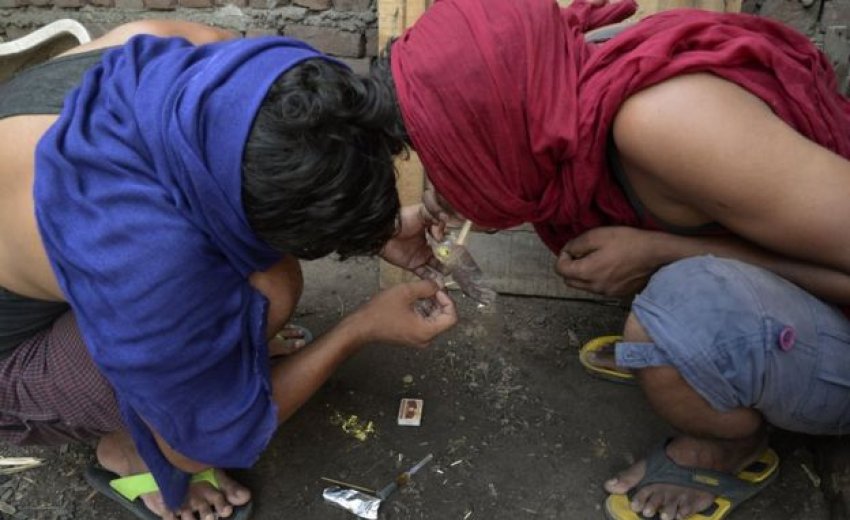Punjab, a treasure trove of rich culture and tradition, once known for its bravery and valor, has its youth trapped in the drug-driven web. In addition to youth, the drug menace affects the general population, including men, women, and children. The fact is that Punjab has a crippling drug problem and no amount of denial can hide it. The affliction has gained a firm footing in this border state of India.
Heart-wrenching stories from Punjab’s hinterland
The misery of Punjab is best explained by sobbing families of drug addicts, children laying in piles of trash with syringes stuck in their veins, and the police-politician-drug nexus.
In 2017, Sanjoy Majumder, a BBC reporter, visited Punjab, one of India's most prosperous states to find out why drug abuse could ruin an entire generation there.
Mukhtiar Singh, a Punjab resident, smiled in dejection as he showed the reporter of BBC a faded photo of his son Manjit. He said to the BBC reporter, "In my wildest dreams I could not imagine what was to happen to him."
Manjit, his 28-year-old son died due to a drug overdose. The father, a worker in the government's power department, marched through the streets of his village carrying his son's body. He then wrote a letter to Prime Minister Narendra Modi. "I told the Prime Minister he needed to step in to save Punjab's youth from drugs. Our children are dying and nothing is being done," he wrote.
Although seven months have passed since the letter was sent, Mr. Mukhtiar Singh still struggles to receive attention on the state of the drug epidemic in Punjab. There are more than 860,000 young men in the state, between the ages of 15 and 35, who use drugs in some form, according to a recent government study. Heroin is the most preferred drug, used by 53% of all addicts. Opium and synthetic drugs such as crystal methamphetamine are also prevalent in Punjab.
Mukhtiar Singh said that his main aim is to save Punjab from this epidemic. He shudders with grief reminiscing the pain he experienced carrying his dead son on his shoulders and does not want any parent to go through this anguish.
Easy access
This problem is so widespread that it is astounding. It is estimated that more than two-thirds of Punjab's households are addicted to drugs. There are young men huddled together in cemeteries, abandoned buildings, or plain fields in different parts of the state, from rural villages in the lush green countryside to bustling metropolitan areas in cities and towns all over the country, smoking, and snorting.
The worst affected area is Tarn Taran, a bustling market town in Punjab, located close to the border of Pakistan.
At the main town's civil hospital, which also serves as an addiction treatment center, young men with glazed eyes hang around. Over 20 minutes, several transactions unfold in full public view. Money is swiftly exchanged in exchange for a little packet by peddlers.
Drugs and Rehabs: An overview
As an ‘overdose’ of death runs in Punjab’s veins, relentless and decisive war on the menace seems to be the only hope.
In Sanjoy Majumder's report, the men who purchase drugs in small packets from peddlers sneak away behind a wall. A derelict building is surrounded by rubbish and smells of urine beyond it. The floor is littered with syringes and broken prescription bottles.
Jasprit Singh, a native of Taran Taran told the BBC reporter, "It's ridiculously easily available.” He was a drug addict for a long time but has left drugs for the past four years.
“Heroin, synthetic drugs - you name it, I've done it all. When I scored for the first time, I felt as if I was experiencing something wonderful. I felt like something had been missing from my life until then."Jasprit Singh admitted to the BBC reporter.
He now works as a counselor for drug addicts at the rehab center where he underwent his recovery process. He aims to purge the sufferers of this menace.
The Hermitage Rehab Center is housed in a two-story building set among lush green lawns. Inmates here receive counseling, psychiatric and medical treatment, and are called students, not patients.
Over the past few years, hundreds of rehab centers have opened across the state. The inmates include judges, policemen, pop musicians, students, and quite a few women as well. JPS Bhatia, the institute's director, says that the women are the most difficult to treat as the majority of the women are abandoned by their families. Most of them have been molested sexually when seeking help from policemen, counselors, and doctors.
The question is, why are its youth so prone?
Punjab shares a border with Afghanistan and Pakistan, making it a major drug smuggling route. This is one of the reasons heroin is so readily available.
The state's agricultural sector, which contributed to its wealth, is stagnating, and unemployment is high due to a lack of industrialization. This is one of the major causes that the youth are in the grip of drugs. Punjab was once ravaged by violent separatist militancy in the 1980s, which has now faded but left scars. Dr. Bhatia says, "We got rid of terrorism only for it to be replaced with narcotics-terrorism."
The epidemic of drug abuse in the young generation has assumed alarming dimensions in Punjab where the rate is three times higher than the national average. Every family member, especially the closest ones, is impacted by drug misuse. It causes family conflicts, strained relationships, divorces, financial strain on the family, fatalities, and in many cases welcomes diseases like HIV/AIDS owing to the usage of needles when injecting intravenous drugs.
Everybody has to band together to put an end to Punjab's drug epidemic. Active cooperation among community leaders and institutions is crucial to the transition to a drug-free Punjab. No battle is easy, especially not the one Punjab is up against.
